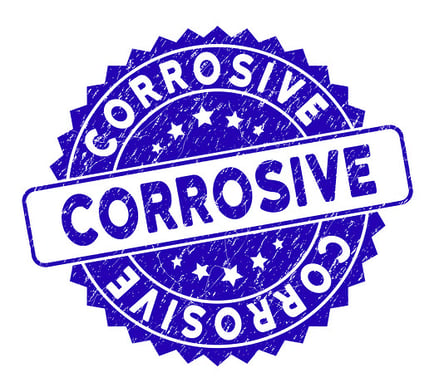The storage of corrosive chemicals, whether liquid or solid, is a tightly controlled process. Many risks present themselves if proper specifications and handling methods are absent. Fires, explosions, leaks and human injury are a few of the unfortunate circumstances that could occur if the warehouse is inadequately constructed, and if warehouse personnel are not sufficiently trained in corrosive storage and handling.
In this article, we identify 5 essential qualities you should look for when choosing a corrosive chemical warehousing provider.
5 Corrosive chemical warehousing essentials
1. OSHA Compliance. Effective chemical storage means safe chemical storage. And an important starting point for chemical warehouse safety is compliance with Occupational Health and Safety Administration (OSHA) requirements.
 Some of OSHA’s key requirements include:
Some of OSHA’s key requirements include:
- Permissible Exposure Limits (PELs). OSHA has set PELs for chemicals and other materials in order to protect employees in the workplace from exposure. Workers are not to be exposed to levels of chemical greater than these PELs. Importantly, states like California have their own exposure limits that are more stringent than the federal ones.
- Hazard Communication Standard (HCS). This standard requires that information related to the identity of chemicals and their associated hazards are clearly communicated to workers and all users who encounter the chemicals downstream from the manufacturer. This information is commonly communicated in the form of Safety Data Sheets (SDS) for each chemical product.
Additional requirements related to corrosives include:
- Corrosives must be stored separately from all processing and handling areas, and kept a safe distance away from other non-compatible chemicals.
- Racking, flooring and walls must be constructed from materials that are resistant to corrosive contact.
- Corrosive area must be well ventilated and labelled with appropriate warning signs.
2. Compliant Warehouse Construction. Storage rooms or areas for corrosive materials have strict specifications as to their construction.
- Mechanical Ventilation: Ventilation systems in warehouses storing corrosive chemicals should achieve a minimum air change rate appropriate to the hazard level of the stored substances, typically around 6-12 air changes per hour.
- Concrete Ramp and Dike: Concrete ramps leading into storage areas must feature a non-slip surface and a slope that accommodates safe movement of chemicals, mitigating spill risks. Surrounding the storage area, a concrete dike of at least 12 inches in height is necessary, designed to contain 110% of the volume of the largest container or 10% more than the total volume of all containers stored, whichever is greater.
- Automatic Sprinkler System: Sprinkler systems in areas storing corrosive materials must use components that are chemically resistant to avoid deterioration.
- Air Inlet and Fireproof Door: Air inlets need to be fitted with filters capable of removing harmful particulates and gases, ensuring a clean supply of air. These inlets should consider external environmental factors like wind direction to minimize potential contamination. Fireproof doors must be self-closing, have a high fire resistance rating, and feature seals to block smoke and flames while allowing easy personnel egress.
4. Hazmat Compliance. Governing agencies will randomly perform audits of hazmat records kept by the warehouse for dangerous goods compliance.
Warehouses must rigorously maintain records of chemical storage, including Safety Data Sheets, inventory logs, and training records, to remain audit-ready. A proactive approach to compliance involves regular self-inspections and adherence to a detailed dangerous goods management program. This program should address correct labeling, storage, disposal practices, and continuous staff training to mitigate the risk of infractions.
Non-compliance here can produce hefty penalties – well into 7+ figure territory. Common infractions include the lack of a dangerous goods storage and disposal program, and a failure to perform adequate training on proper chemical management.
Such systems should utilize barcode or RFID technology to track chemical locations and quantities accurately, with the capability to monitor storage conditions. You’ll also want a provider that can integrate its systems with yours – offering you direct access to inventory data, order tracking, and safety information.
Turn to Weber Logistics for corrosive chemical storage
If you’re looking for chemical warehousing on the West Coast, look no further than Weber.
Chemical logistics has been a strategic focus of ours since 1985. We have an internal quality control team that performs regular audits of all operations to examine and optimize Sanitation, Security, and Safety measures (known as our “Triple S” audit). Also, we are active members of key chemical associations like the National Association of Chemical Distributors (NACD), which performs an external audit of our operations annually.
These rigorous compliance measures are supported by a seasoned staff of chemical experts that average 15 years in the industry. To learn more about the ways that Weber can support your West Coast corrosive chemical operations, contact us today.





 Capital Management
Capital Management